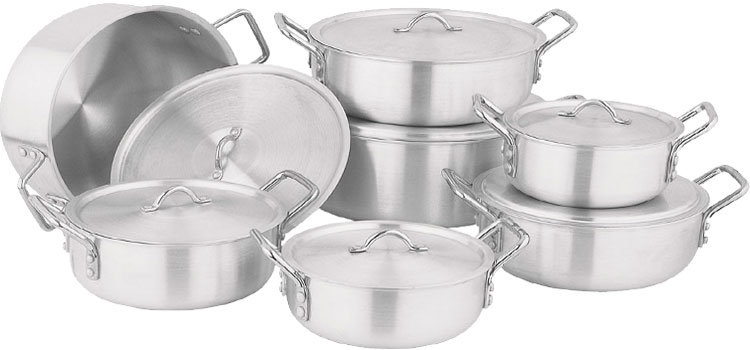
Aluminum cookware, a long-standing fixture in kitchen spaces globally, has garnered favor due to its economical pricing and superb thermal conductivity, traits that have sustained its popularity for decades. Nevertheless, recent regulatory measures in Europe have cast a shadow over its usage, citing burgeoning health apprehensions. This comprehensive exposition delves into the rationales underpinning this proscription scrutinizes the conceivable health hazards linked to aluminum cookware deployment, juxtaposes it with alternative substrates, and furnishes insights into safer culinary avenues.
What Is Aluminium Cookware?
Aluminum cookware, forged from the resilient metal aluminum renowned for its feathery texture and adeptness in disseminating heat uniformly, finds common employment in the crafting of cooking vessels, skillets, and kitchen implements, thanks to its economical viability and robustness.
Is it bad to use aluminum cookware?
Albeit the ubiquitous use of aluminum cookware, there looms a pall of doubt regarding its innocuousness, particularly when tasked with the culinary preparation of acidic or richly spiced victuals. Aluminum can seep into comestibles, especially under elevated temperatures or in conjunction with acidic constituents, thereby eliciting plausible health perils.
Why is aluminium not safe for cooking?
A principal apprehension encircling aluminum cookware revolves around the likelihood of aluminum transmigration into victuals during the cooking process. This phenomenon is especially pronounced when concocting acidic fare such as tomato-based dishes or utilizing sharp-edged implements that scuff the cookware’s surface, laying bare the aluminum substrate beneath.
The 10 Reasons Why Aluminium Cookware Banned In Europe:
- Health Perils: Apprehensions concerning the potential health repercussions attendant upon aluminium exposure, inclusive of purported correlations with neurological maladies like Alzheimer’s ailment.
- Ecological Ramifications: The production and disposal mechanisms associated with aluminium engender environmental degradation and resource depletion.
- Gastronomic Safety: European regulatory frameworks accord precedence to alimentary safety and have outlawed materials that might leach deleterious agents into comestibles.
- Patron Shielding: The ban is devised to safeguard consumers against conceivable health hazards associated with the deployment of aluminium cookware.
- Statutory Adherence: Manufacturers are mandated to adhere to stringent directives promulgated by the European Union, governing the constituents employed in food-contact merchandise.
- Substitutive Substrates: Healthier alternatives to aluminium cookware abound, aligning with both health and ecological imperatives.
- Public Cognizance: A burgeoning cognizance among consumers regarding the plausible health hazards of aluminium cookware has catalyzed the demand for safer substitutes.
- Empirical Inquiry: Research endeavors spotlighting the health ramifications of aluminium exposure have wielded influence over regulatory adjudications.
- Corporate Retort: Some manufacturers have volitionally phased out the production of aluminium cookware in response to consumer clamor for safer alternatives.
- Global Paradigms: The prohibition conforms with global trends advocating for safer and more sustainable culinary practices.
Why is aluminum no longer used for manufacturing cooking pots?
In light of concerns over aluminium leaching into foodstuffs and precipitating health risks, numerous manufacturers have veered away from incorporating aluminium in the production of cooking vessels. Instead, they gravitate towards safer substrates such as stainless steel, cast iron, or ceramic coatings.
Which is safer stainless steel or aluminum?
Stainless steel generally garners acclaim as a safer alternative to aluminium for culinary pursuits. It refrains from imparting deleterious substances into comestibles and boasts superior durability and resistance to abrasion vis-à-vis aluminium.
Is Aluminium Superior to Nonstick Coatings?
Aluminum cookware frequently serves as the foundational underpinning for nonstick coatings, courtesy of its stellar thermal conductivity. However, qualms regarding aluminum’s leaching proclivities have instigated a predilection for nonstick coatings applied onto substrates deemed safer, such as stainless steel or ceramic.
In Summation:
The proscription on aluminium cookware in Europe epitomizes mounting anxieties surrounding the plausible health hazards associated with its utilization. While aluminium cookware may proffer affordability and thermal conductivity, the specter of aluminium infiltration into victuals and its environmental footprint have prompted regulatory intervention. Consumers are enjoined to opt for safer alternatives such as stainless steel, cast iron, or ceramic-coated cookware, thereby prioritizing their well-being and fostering sustainable culinary practices for present and future cohorts. By exercising discernment in their selection of cookware substrates, individuals can advocate for safer and more ecologically sound culinary paradigms.
